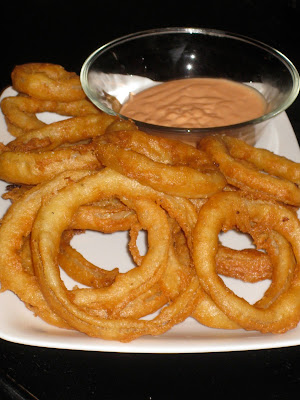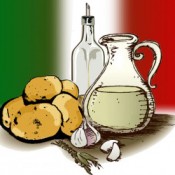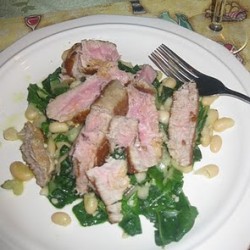
Over the past few years, I have started to develop a taste and understanding for quality beers. Along with it has come the appreciation of pairing a good beer with food. Just as you would choose which wine to serve with you meal, a nice beer selection can often help accentuate the flavors of just about any dish. It’s not uncommon for me to now consider what beer to order or serve before selecting or preparing my main course. Needless to say, I was very excited when my sister-in-law (a.k.a. my SIL) gave me a cookbook full of beer-based recipes. We’re talking way more than just a hot dog beer boil here, people. Just as you would select the proper oil or vinegar as a liquid base, the style of beer that you use can help bring out a sweet maltiness to a sauce or a hoppy essence to a marinade. I’ll be sure to share some recipes with you as I experiment with this book. Thank you SIL!
This week, my good friend Emma shares with us her own beer-infused recipe…Gluten-Free Beer Battered Onion Rings! Just the combination of beer and home-made onion rings alone is enough to make my mouth water. But to put the two together? Genius!!!
Also featured this week is a delectable recipe from the one and only Una Mamma Italiana, as she shares with us her recipe for Italian Herb Beer Bread. Be sure to check out the Una Mamma Italiana blog for this and many more creative and tasty dishes.
Mangia and enjoy!
GLUTEN-FREE BEER BATTERED ONION RINGS

By Emma Caperelli Loerky
A few weeks ago my husband celebrated his birthday. When I asked him how he’d like to spend his day, he immediately spewed off a dinner and dessert menu. The menu consisted of filet mignon, sauteed mushrooms, Caesar salad, onion rings, and for dessert he asked for a key lime pie. Since my husband has Celiac disease, I knew I’d need to make some adjustments, but I felt that all of the things on the menu seemed pretty doable. I had a recipe for Caesar dressing that I had been wanting to try (no dairy and no raw egg), gluten-free croutons couldn’t be that hard (they weren’t and they were delicious!), I’ve made mushrooms countless times, and my husband is in charge of grilling the steaks. Even the pie, without the dairy and gluten, didn’t faze me. But the thought of making onion rings made me cringe.
You see, a few months ago I attempted to make gluten-free onion rings without success. They were greasy and gritty and I was in no rush to try my hand at making them again. However, being someone who adores onion rings, I completely understood how they would make this pretty basic dinner seem special, so I decided to try again. Am I glad I did! My experience making them this time was so much better than the last and the results were spectacular. Aside from the onion rings at my favorite BBQ joint, these were the best I’ve had. No lie.
The key is to have everything set up and ready to go. You want to make sure you have your oven preheated to 200 degrees (to keep the cooked onion rings warm while you are frying up the rest), a wire rack lined with paper towels close by, as well as a cookie sheet to transfer the freshly fried rings to the oven on. Oh, and lets not forget the batter and the onions themselves. It needs to be sort of an assembly line. Once that is accomplished, you want to make sure that you have your oil at the perfect temperature. If your oil isn’t hot enough, they will end up greasy and inedible. If it is too hot, they will burn QUICKLY. Even at the right temperature, these cook very fast, so you don’t want to let them out of your sight for very long. The time it takes you to transfer the rings to the oven is about all I would allow myself to be away from the frying pan. I used a cooking/candy thermometer to make sure that my oil was at the perfect frying temperature (365 degrees).
I almost forgot to mention the dipping sauce, which complimented the onion rings perfectly. In a nutshell – MAKE IT! Do yourself a favor though, double the recipe. I certainly will next time.
Both recipes are adapted from http://www.glutenfreecookingschool.com/archives/lazy-mans-beer-battered-onion-rings/
Ingredients
1 Large Vidalia onion (or other sweet onion)
Approximately 2 cups soy milk
2 tbsp lemon juice
**Note: If you aren’t lactose intolerant, omit the soy milk and lemons and use buttermilk.
1 1/2 cups brown rice flour
1 tsp salt
about
1/8 tsp black pepper
1 tbsp canola oil
2 eggs, lightly beaten
3/4 cup Redbridge Beer **(This is the amount the original recipe calls for, however, I had to add at least and additional 1/4 cup, possibly 1/2 cup more in order to get the right consistency. Unfortunately, I didn’t measure exactly how much I added. Start off with the recommended amount and slowly add more beer until it’s a nice thick consistency, similar to a pancake batter.)
Vegetable oil (for frying)
Directions
Mix together the lemon juice and soy milk and let stand while you slice the onions into rings about 1/2 inch wide. Soak the onions in the soy milk mixture (or buttermilk) for about an hour in the fridge. Make the beer batter by mixing all remaining ingredients, adding as much beer as described above. Let the batter rest in the fridge while the onions soak.
After about an hour, heat enough vegetable oil to coat a large frying pan (or cast iron skillet) by about 1 inch. The temperature should read 365 degrees on a thermometer. Drain the onions in a colander while waiting for the oil to come to temperature. When the oil is ready, dip the onion rings, one at a time, into the batter and gently lower them into the hot oil. Do not overcrowd the pan. After approximately 3 minutes, flip the rings and cook on the other side for about another 3 minutes. They should be a light golden color when finished. Transfer the rings to a wire rack lined with paper towels to drain the excess oil and sprinkle with additional salt while they are still hot. Repeat with the remaining onions, keeping the cooked onion rings warm in the oven.
Creamy Wasabi Dipping Sauce
Ingredients
1/4 cup mayonnaise
1/4 cup sour cream or plain yogurt (I couldn’t find plain soy yogurt, so I just used 1/2 cup mayonnaise)
2 heaping tsp ketchup
1 heaping tsp tomato paste
1 tsp Wasabi paste (I used a bit more)
Dash of Tabasco sauce (This was a last minute addition made my me but can be omitted)
Salt, black pepper, and cayenne pepper to taste
Mix all ingredients together thoroughly and enjoy.
ITALIAN HERB BEER BREAD

By Una Mamma Italiana
Most simple Italian recipes stem from the poor regions of Italy, where they cooked with whatever foods grew regionally. I’m talking about authentic Peasant Food, which happens to be my FAVORITE way to eat Italian. Don’t get me wrong, I can appreciate gourmet Italian fare, but I grew up on the simple flavors of Italian cooking straight from the garden. This is one of those recipes.
Ingredients
3 cups flour
1 Tbsp baking Powder
2 tsp garlic powder
1 tsp sugar
1 tbsp Italian Seasoning
2 tsp salt
12 z. beer
Directions
Mix all dry ingredients. Add the beer and stir (dough will be slightly wet, like a biscuit dough). Place dough in a well oiled loaf pan. Brush the top with Extra Virgin Olive Oil. Bake at 350 degrees for 45 minutes. Once it comes out of the oven, brush the top with e.v.o.o. again and sprinkle with sea salt. Let cool for 10 minutes, then slice.
BONUS RECIPE!!!
As coincidence may have it, Una Mamma has also posted a tasty Onion Ring recipe this week on her blog. Since I was FINALLY able to put an end to her ongoing food challenge victories, I thought it would only be appropriate that I share with you the link to her Italian Fried Onion Rings as well. Enjoy!








Recent Comments